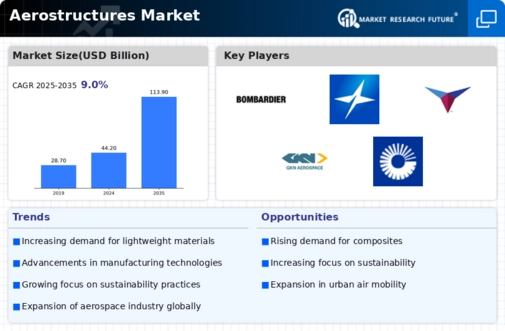Aerostructures Size
Aerostructures Market Growth Projections and Opportunities
The Aerostructures Market is known for having ever-changing factors that shape the whole of aerospace industry. A major propellant of such a dynamic market is the consistent growth in global aviation. Rising passenger numbers, expanding middle class populations and economic growth will continue to drive up air travel demand. The need to increase production capacities has compelled aircraft manufacturers to consider aerostructures as key components that include wings, fuselage, empennage, and structural parts of any plane. This is because these are essential determinants for meeting demand in commercial and military planes that keep on rising. This simply means that the dynamics at play in the Aerostructures Market are closely related with the general condition and expansion patterns within aviation industry where they meet changes imposed by aircraft makers.
Technological advancements are highly influential when it comes to shaping the dynamics of Aerostructures market environment. To improve design, materials as well as manufacturing process of aerostructures, aerospace manufacturers have been engaged in research and development activities throughout their history. In other words, striving for lightweight materials, advanced composites, and more efficient manufacturing techniques reflect an overall goal across the sector to attain fuel efficiency, reduce emissions while improving on overall aircraft performance among others. Therefore this aligns them with other cutting edge technologies that usually enable them conforming to strict regulatory requirements on fuel efficiency detailing why firms use it as their selling point.
Globalization together with international collaborations is one of those affecting factors which characterizes Aerostructures Market dynamics. Aerospace companies often partner or enter into joint ventures or collaborations with different players in the industry sometimes worldwide. This can especially be seen in large scale commercial airplane programs which require global cooperation for proper handling complexities associated with designing purposes or its assembly lines among others. Collaborative efforts achieve this through optimizing resource utilization from various sources onto innovative yet cost effective aerostructures by different bodies involved herein who possess knowledge about such entities involved here too creating novel cost-effective aerostructures according to their expertise. The Aerostructures Market dynamics are greatly influenced by the success of companies in navigating through and benefiting from global partnerships to meet international aerospace demands.
Regulatory frameworks and environmental concerns significantly impact the Aerostructures Market. The aviation industry is subject to stringent regulations that focus on safety, environmental sustainability and fuel efficiency. This suggests that these regulations have a bearing on design as well as manufacturing processes of aerostructures. Simultaneously, there is an increasing consciousness about environmental sustainable which has led the industries into searching for eco-friendly materials and methods of production. They comply with required legislation about environment or establish themselves as key players if they become proactive towards meeting environmentally-driven expectations or regulatory requirements taking place in the market thereby aligning with wider industry trends.
Market consolidation and mergers and acquisitions (M&A) activities contribute to the dynamics of the Aerostructures Market. Aerospace firms often engage in M&A transactions in order to improve their prowess, widen their product offering(s), and gain economies of scale. Moreover, when some major players combine their operations together it affects market forces because competition changes rapidly while pricing decisions usually take quite long before being adjusted according to new circumstances available within an economy at any given time hence this provides them also more comprehensive or diversified offerings as well; thus such consolidations tend alter competitively strategies pricing influence landscape inside market concerning aeroproducts where they operate within towards this direction either everything remains constant leading us back not much progress made until now.. The outcome is increased production capacities, better research and development capabilities, as well as secure market positions for various players involved here during merger exercises done here today either alone or combined will help produce better results for all parties concerned thereafter so that everyone can work together effectively within one big company
Further, the Aerostructures Market is shaped by a balance between Original Equipment Manufacturers (OEMs) and suppliers. In this regard, OEMs may decide to bring in-house some of the manufacturing processes that are involved in making an aerostructure while seeking to optimize their supply chains, reduce costs and maintain control of critical components. Nevertheless, suppliers have crucial roles in providing specialized knowledge, economical solutions and just-in-time delivery of aerostructures. Sourcing decisions, supplier relationships and thus overall competitiveness of both OEMs and suppliers in the Aerostructures Market are influenced by these dynamics.
Economic factors as well as geopolitical considerations also influence Aerostructures Market dynamics. Such economic trends as fluctuations in global GDP figures, interest rates and currency exchange rates determine the affordability level for new planes as well as demand for them. On the other hand, geopolitical issues such as trade wrangles or political stability can affect inflow of orders and affect aerospace companies’ strategic decision making processes. The dynamic nature of the Aerostructures Market is closely associated with broader economic factors together with geo-political landscape which necessitates organizations to deal with uncertainties and adapt to changeable market forces.”









Leave a Comment